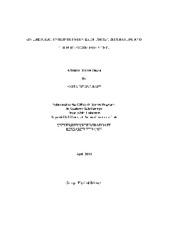| dc.creator | Rapp, Anita Denise | |
| dc.date.accessioned | 2013-02-22T20:40:12Z | |
| dc.date.available | 2013-02-22T20:40:12Z | |
| dc.date.created | 2000 | |
| dc.date.issued | 2013-02-22 | |
| dc.identifier.uri | https://hdl.handle.net/1969.1/ETD-TAMU-2000-Fellows-Thesis-R375 | |
| dc.description | Due to the character of the original source materials and the nature of batch digitization, quality control issues may be present in this document. Please report any quality issues you encounter to digital@library.tamu.edu, referencing the URI of the item. | en |
| dc.description | Includes bibliographical references (leaves 34-36). | en |
| dc.description.abstract | The impact of tropical precipitation on the global energy budget has long been an important topic of investigation. To more accurately assess large-scale heating, we must first understand the small scale cloud processes that make up tropical precipitation. In particular, we must relate observations obtained from remote sensing platforms, such as satellites, to the physical properties of clouds. This research aids that goal by relating microwave signatures observed in convective clouds to the cloud's stage of evolution, as diagnosed using weather radar. By studying the brightness temperature at four different frequencies, 10.7 GHz, 19.35 GHz, 37.1 GHz, and 85.5 GHz, throughout the life cycle of a convective cell, we are better able to document the evolution of the differing amounts and combinations of liquid and frozen hydrometeors. This is key to understanding the cloud's radiative processes and precipitation production. The data will be taken from the National Aeronautics and Space Administration Tropical Rainfall Measuring Mission Kwajalein Experiment. Reflectivity data from the Kwajalein radar and brightness temperature data from the Advanced Microwave Precipitation Radiometer will be used to investigate a storm system that was sampled continuously from 0056-0214 UTC on 29 August 1999. This continuous data set offers an opportunity to evaluate the relationship between brightness temperature and thunderstorm evolution within tropical convective systems. Analysis of the convective cells within this system shows that proper interpretation of measured brightness temperatures requires knowledge of the thunderstorm evolution. In particular, the combination of low 85 GHz brightness temperature with moderately strong 10 GHz brightness temperatures was found to be associated with dissipating convective cells. These results show that the study of convective cell evolution is an important part in understanding cloud radiative processes. | en |
| dc.format.medium | electronic | en |
| dc.format.mimetype | application/pdf | |
| dc.language.iso | en_US | |
| dc.publisher | Texas A&M University | |
| dc.rights | This thesis was part of a retrospective digitization project authorized by the Texas A&M University Libraries in 2008. Copyright remains vested with the author(s). It is the user's responsibility to secure permission from the copyright holder(s) for re-use of the work beyond the provision of Fair Use. | en |
| dc.subject | physical sciences. | en |
| dc.subject | Major physical sciences. | en |
| dc.title | On the relationship between brightness temperature and thunderstorm evolution | en |
| thesis.degree.department | physical sciences | en |
| thesis.degree.discipline | physical sciences | en |
| thesis.degree.name | Fellows Thesis | en |
| thesis.degree.level | Undergraduate | en |
| dc.type.genre | thesis | en |
| dc.type.material | text | en |
| dc.format.digitalOrigin | reformatted digital | en |


